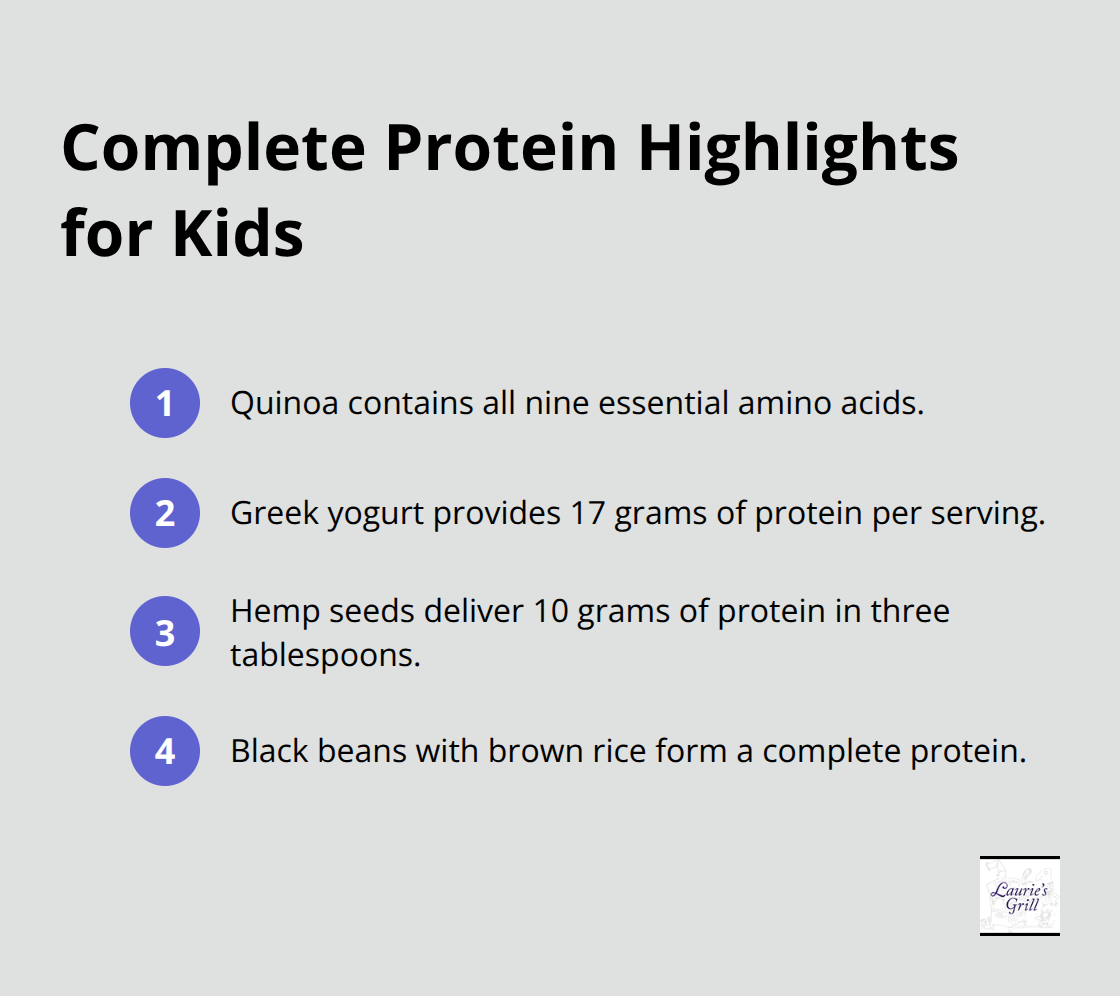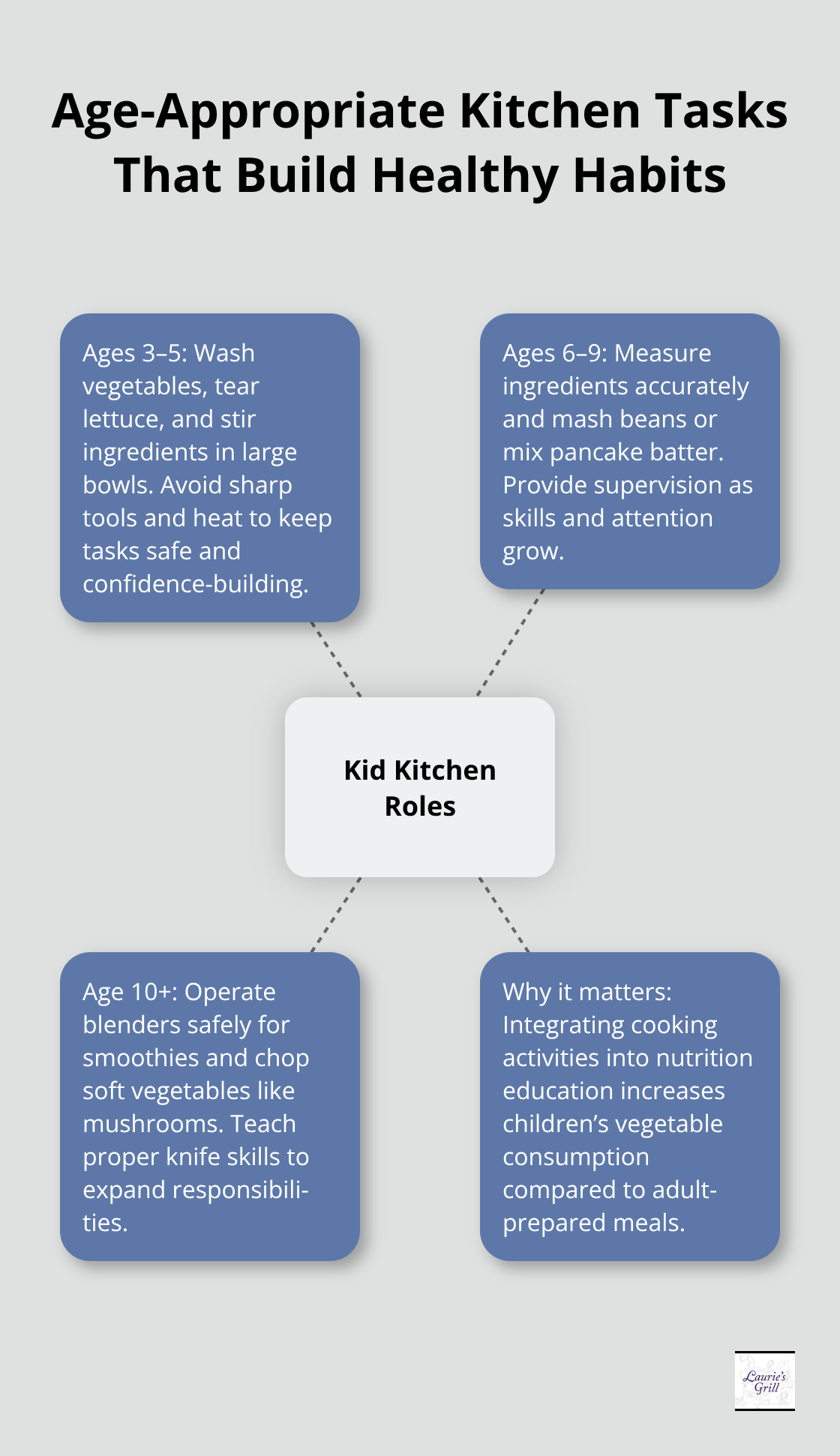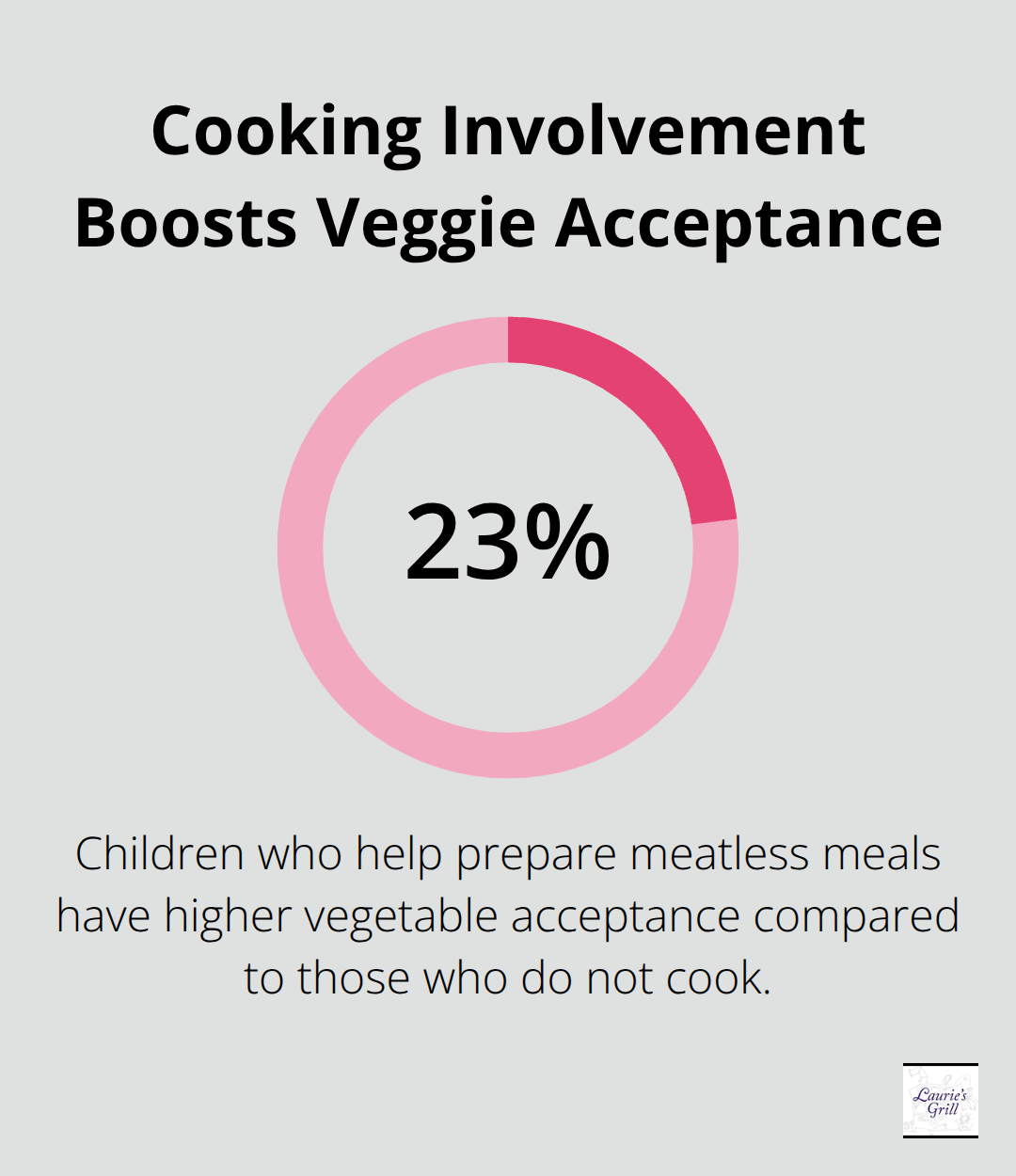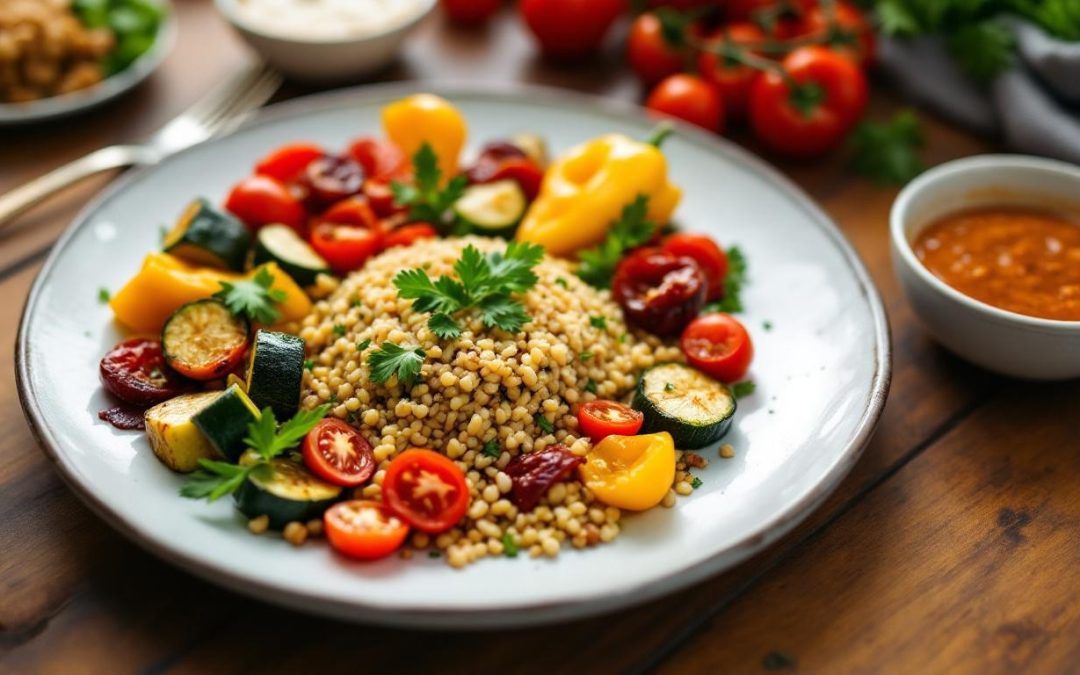Family-friendly meatless meals don’t have to be complicated or boring. Research shows that families eating one plant-based meal per week reduce their carbon footprint by 8% annually.
We at Laurie’s Grill know that getting kids excited about vegetables starts with smart planning and creative recipes. The right approach makes meatless cooking both nutritious and enjoyable for everyone at the table.
Understanding Complete Protein Sources for Growing Kids
Children need 13-19 grams of protein daily according to the USDA, but complete proteins matter more than total amounts. Quinoa provides all nine essential amino acids in a single grain, which makes it superior to rice or pasta for family meals. Black beans paired with brown rice create complete proteins when families eat them together, while Greek yogurt contains 17 grams of protein per serving. Hemp seeds pack 10 grams of protein in just three tablespoons and blend invisibly into smoothies or pasta sauces.

Smart Protein Combinations That Work
Peanut butter on whole wheat bread delivers complete proteins through strategic pairing. Hummus with pita bread creates another combination that kids love. Lentil soup with cornbread provides all essential amino acids while it feels like comfort food. Plant proteins contain higher levels of some amino acids that are beneficial to health, making these combinations effective for children who grow rapidly.
Balance Macronutrients Without Stress
Plant-based meals need proper fat and carbohydrate ratios alongside protein. Avocado adds healthy fats to bean bowls (plus kids love the creamy texture). Sweet potatoes provide complex carbohydrates that sustain energy for active children. Nuts and seeds contribute both protein and essential fatty acids that support brain development.
Weekly Meal Plans That Save Time
Sunday batch preparation transforms weeknight stress into simple reheating. Cook one large pot of quinoa, roast three sheet pans of mixed vegetables, and prepare two protein sources like seasoned chickpeas and hard-boiled eggs. This creates 15 different meal combinations throughout the week. Store everything in glass containers for quick assembly. Parents report they save 4-5 hours weekly with this systematic approach while they spend 40% less on groceries compared to daily meal preparation.
These protein strategies work best when you pair them with recipes that kids actually want to eat.
Simple Meatless Recipes Kids Actually Love
Pasta dishes loaded with protein work when vegetables disappear into creamy sauces. Butternut squash mac and cheese takes 25 minutes and hides two cups of pureed squash in cheese sauce while it delivers 12 grams of protein per serving. White bean pasta with ricotta creates restaurant-quality meals in one pot, where cannellini beans blend seamlessly with pasta water to create natural creaminess. Greek yogurt mixed into marinara sauce doubles protein content to 8 grams per half-cup while kids taste only familiar tomato flavors.
Transform Beans Into Comfort Food Winners
Lentil sloppy joes fool even picky eaters when red lentils replace ground meat in traditional recipes. The texture matches perfectly, and one cup of cooked lentils provides 18 grams of protein. Chickpea nuggets made with mashed chickpeas, breadcrumbs, and spices bake into crispy finger foods that kids grab first. Black bean quesadillas work every time because melted cheese masks any bean texture concerns while it adds 15 grams of protein per serving.
Breakfast Becomes the Easiest Meatless Win
Protein pancakes made with cottage cheese and oats deliver 4 grams of protein per pancake while they taste like regular pancakes. Blend one cup cottage cheese with half cup oats and two eggs for batter that satisfies kids for hours. Overnight oats with chia seeds provide 14 grams of protein when you prepare them with Greek yogurt, and kids love to choose their own toppings the next morning. Breakfast burritos stuffed with scrambled eggs, black beans, and cheese freeze perfectly for busy school mornings and contain 16 grams of complete protein.
Make Vegetables Disappear Into Favorite Foods
Cauliflower pizza crust tricks kids into eating vegetables while they enjoy their favorite meal. Zucchini noodles work best when you mix them 50/50 with regular pasta (kids won’t notice the difference). Sweet potato fries baked with a light coating of cornmeal satisfy french fry cravings while they provide beta-carotene and fiber that regular potatoes lack.
Success with these recipes sets the foundation for the next step: getting kids actively involved in the kitchen where they develop ownership over their food choices.
Getting Kids Involved in Meatless Cooking
Children ages 3-5 can wash vegetables, tear lettuce, and stir ingredients in large bowls without sharp tools or heat sources. Kids aged 6-9 handle measuring cups accurately and can mash beans for burger patties or mix pancake batter with supervision. Children 10 and older operate blenders safely for smoothies and can chop soft vegetables like mushrooms with proper knife skills training. Research shows that integrating cooking activities into nutrition education increases vegetable consumption among children compared to meals prepared entirely by adults.

Turn Kitchen Time Into Nutrition Lessons
Teaching kids that quinoa contains all nine essential amino acids works best when they feel the different textures of grains while they cook. Show children how lentils double in size during preparation to demonstrate protein expansion visually. Kids understand fiber better when they compare whole wheat pasta to regular pasta side by side. Studies indicate that hands-on nutrition education through cooking activities helps children better understand healthy eating concepts. Count grams of protein together when you read nutrition labels on Greek yogurt, nuts, and beans during meal preparation.
Create Weekly Prep Sessions as Family Time
Assign each child one complete task rather than rotation through stations. One child washes all produce while another measures dry ingredients for the entire week. This approach prevents kitchen chaos and gives kids ownership over specific responsibilities. Families who prep together for 90 minutes on Sundays report 65% less weeknight stress according to meal planning surveys. Create assembly lines for burrito bowl ingredients or overnight oats where each family member adds their designated component.
Set Up Kid-Friendly Kitchen Organization
Store prepared ingredients in clear containers at kid-friendly heights so children can build their own meals during the week. Label containers with both words and pictures for younger children who cannot read yet. Place measuring cups and mixing bowls in lower cabinets where kids can reach them independently (this builds confidence in kitchen skills). Keep a step stool near the counter so shorter children can participate safely in food preparation activities.
Final Thoughts
Regular family-friendly meatless meals deliver measurable benefits beyond nutrition. Families save an average of $1,200 annually when they replace meat with plant proteins twice weekly. Children who participate in meatless meal preparation show 23% higher vegetable acceptance rates compared to those who don’t cook.

Environmental impact drops significantly with each plant-based meal (reducing water usage by 200 gallons per family dinner).
Start with one meatless day per week to remove pressure while you build new habits. Choose the same day each week to create routine. Monday works well because kids return from weekends ready for structure. Pick three reliable recipes that your family already enjoys, then rotate them monthly to prevent boredom.
Small wins build confidence rather than dramatic changes create success. Master one protein source like lentils before you add quinoa or tempeh. Let kids choose vegetables for pasta dishes so they feel invested in meals. We at Laurie’s Grill understand that family meals bring people together, whether they include meat or focus on plants, creating lasting memories around the dinner table.


Recent Comments